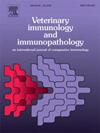Functional additive containing β-glucan, proanthocyanidins and saponins improves growth, immunity and gut health in rainbow trout
IF 1.4
3区 农林科学
Q4 IMMUNOLOGY
引用次数: 0
Abstract
This study evaluated the effects of a β-glucan, proanthocyanidin, and saponin-based additive on growth performance, innate immunity, intestinal morphometry, water quality, and disease resistance in rainbow trout (Oncorhynchus mykiss). Experimental groups were designated GPS 1 (1.35 g/kg), GPS 2 (2.025 g/kg), and GPS 3 (2.7 g/kg) based on the additive’s key ingredients, with a non-supplemented control (CO) for comparison. Fish were fed these diets for 90 days. Fish fed GPS 2 exhibited significantly higher final weight, weight gain, and specific growth rate than CO. Plasma hemolytic activity (complement activity) was highest in GPS 1 and GPS 2. Lysozyme and myeloperoxidase activity were significantly greater in GPS 1. GPS 3 showed the highest superoxide anion production in blood leukocytes and elevated reactive oxygen species levels in plasma, but also the lowest free circulating DNA (dsDNA) concentrations. Intestinal morphometry analysis revealed greater villous height in GPS 1, followed by GPS 2, while villous density and total absorptive surface area were highest in GPS 2, followed by GPS 1. The intraepithelial lymphocyte score was significantly higher in GPS 3 than in CO. Water quality analysis showed significantly lower ammonia and nitrite levels in all supplemented groups after 48 h in a closed-system assay designed to evaluate nitrogenous waste accumulation. The bacterial challenge revealed higher survival rates in the supplemented groups (GPS 1: 95 %; GPS 2 and GPS 3: 100 %) compared to CO (70 %). In conclusion, GPS 2 provided the most balanced benefits, optimizing growth, immune response, intestinal integrity, and survival. GPS 3 appeared to induce a predominantly oxidative immune response, accompanied by an increase in intraepithelial lymphocyte density, suggesting enhanced mucosal immune activity. GPS 1 exhibited a robust immune response alongside improvements in intestinal histology. Overall, all three tested inclusion levels provided health and performance benefits when compared to the control group.
含有β-葡聚糖、原花青素和皂苷的功能性添加剂促进虹鳟鱼生长、免疫和肠道健康
本研究评估了β-葡聚糖、原花青素和皂素添加剂对虹鳟生长性能、先天免疫、肠道形态、水质和抗病性的影响。根据添加剂的关键成分选择GPS 1(1.35 g/kg)、GPS 2(2.025 g/kg)和GPS 3(2.7 g/kg)试验组,并以不添加CO作为对照。饲喂这些饲料90天。饲用GPS 2的鱼的最终体重、增重和特定生长率均显著高于饲用CO。血浆溶血活性(补体活性)以GPS 1和GPS 2最高。溶菌酶和髓过氧化物酶活性显著高于gps1。GPS 3显示出血液白细胞超氧阴离子产量最高,血浆活性氧水平升高,但游离循环DNA (dsDNA)浓度最低。肠道形态分析显示,GPS 1组的绒毛高度最高,GPS 2组次之,GPS 2组的绒毛密度和总吸收表面积最高,GPS 1组次之。在GPS 3中,上皮内淋巴细胞评分显著高于CO。水质分析显示,在48 h后,所有补充组的氨和亚硝酸盐水平均显著降低。细菌攻击显示,补充组的存活率更高(GPS 1:95 %;GPS 2和GPS 3: 100 %)与CO(70 %)相比。综上所述,GPS 2提供了最平衡的效益,优化了生长、免疫反应、肠道完整性和生存。GPS 3似乎诱导了主要的氧化免疫反应,并伴有上皮内淋巴细胞密度的增加,表明粘膜免疫活性增强。GPS 1在肠道组织学改善的同时表现出强大的免疫反应。总的来说,与对照组相比,所有三个测试的纳入水平都提供了健康和性能方面的好处。
本文章由计算机程序翻译,如有差异,请以英文原文为准。
求助全文
约1分钟内获得全文
求助全文
来源期刊
CiteScore
3.40
自引率
5.60%
发文量
79
审稿时长
70 days
期刊介绍:
The journal reports basic, comparative and clinical immunology as they pertain to the animal species designated here: livestock, poultry, and fish species that are major food animals and companion animals such as cats, dogs, horses and camels, and wildlife species that act as reservoirs for food, companion or human infectious diseases, or as models for human disease.
Rodent models of infectious diseases that are of importance in the animal species indicated above,when the disease requires a level of containment that is not readily available for larger animal experimentation (ABSL3), will be considered. Papers on rabbits, lizards, guinea pigs, badgers, armadillos, elephants, antelope, and buffalo will be reviewed if the research advances our fundamental understanding of immunology, or if they act as a reservoir of infectious disease for the primary animal species designated above, or for humans. Manuscripts employing other species will be reviewed if justified as fitting into the categories above.
The following topics are appropriate: biology of cells and mechanisms of the immune system, immunochemistry, immunodeficiencies, immunodiagnosis, immunogenetics, immunopathology, immunology of infectious disease and tumors, immunoprophylaxis including vaccine development and delivery, immunological aspects of pregnancy including passive immunity, autoimmuity, neuroimmunology, and transplanatation immunology. Manuscripts that describe new genes and development of tools such as monoclonal antibodies are also of interest when part of a larger biological study. Studies employing extracts or constituents (plant extracts, feed additives or microbiome) must be sufficiently defined to be reproduced in other laboratories and also provide evidence for possible mechanisms and not simply show an effect on the immune system.

 求助内容:
求助内容: 应助结果提醒方式:
应助结果提醒方式:


